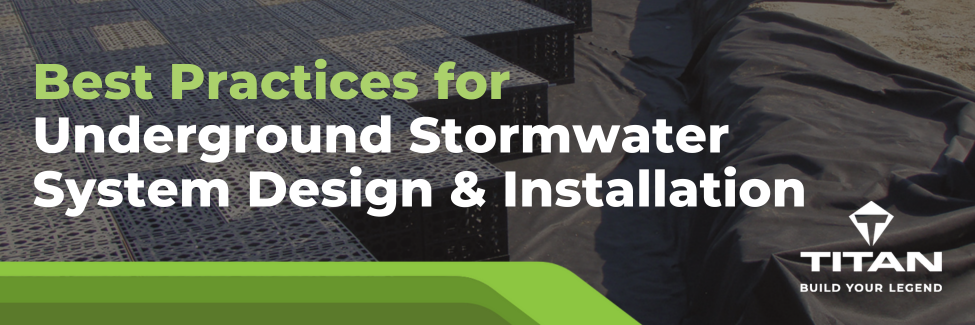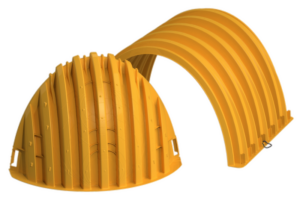The success of an underground management system depends on a sound design and the correct installation. While all applications are unique and site-specific, there are high level steps engineers should consider to ensure a functional system is designed and installed:
- Arch Chambers vs Modular Tanks
- Infiltration, Retention, or Detention?
- Pre-Design Project Site Assessment
- Material Requirements
- Installation & Maintenance Requirements
Successful underground stormwater management systems offer several benefits:
- Flood reduction
- Improved water quality
- Space saving
- Enhanced property value
- Easy maintenance
- Sustainability
Arch Chambers vs. Modular Tanks
The two most recommended underground stormwater management systems are arch chambers and modular tanks.
Arch Chambers
The arch chamber system consists of open bottom chambers with little empty space. They’re less expensive than modular tanks to purchase, but they require more space and backfill. This can increase project costs and result in a higher carbon footprint.
Modular Tanks
The modular tank system consists of stackable blocks with significant void space. Modular tanks have a higher void ratio than other options on the market, meaning they can store the largest volume of stormwater in the smallest footprint. However, they have a higher requirement for assembly.
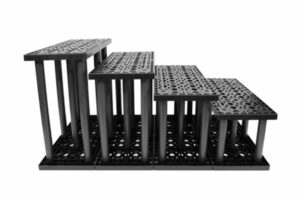
The choice between these systems depends on site-specific conditions, budgetary constraints, and application type = infiltration, retention, or detention.
Infiltration, Retention, or Detention?
Underground stormwater systems incorporate either an impermeable geomembrane or a permeable non-woven geotextile depending on if the system is meant for infiltration, retention or detention.
Infiltration-focused applications include non-woven geotextiles around the chamber or tank and the granular stone at the excavation line. This allows the water to be stored in a temporary basin for it to percolate down into the bedding layer and native soils to recharge the groundwater.
Retention-focused systems include an impermeable liner either wrapped around the chamber or tank or wrapped around the granular material. This prevents infiltration for various reasons, including concern over contaminated soil or the presence of groundwater. This method allows for rainwater harvesting to be used for irrigation.
Detention is meant to slow the release of water and reduce peak runoff downstream based on the outlet or orifice sizing. This type of application may or may not include an impermeable geomembrane.
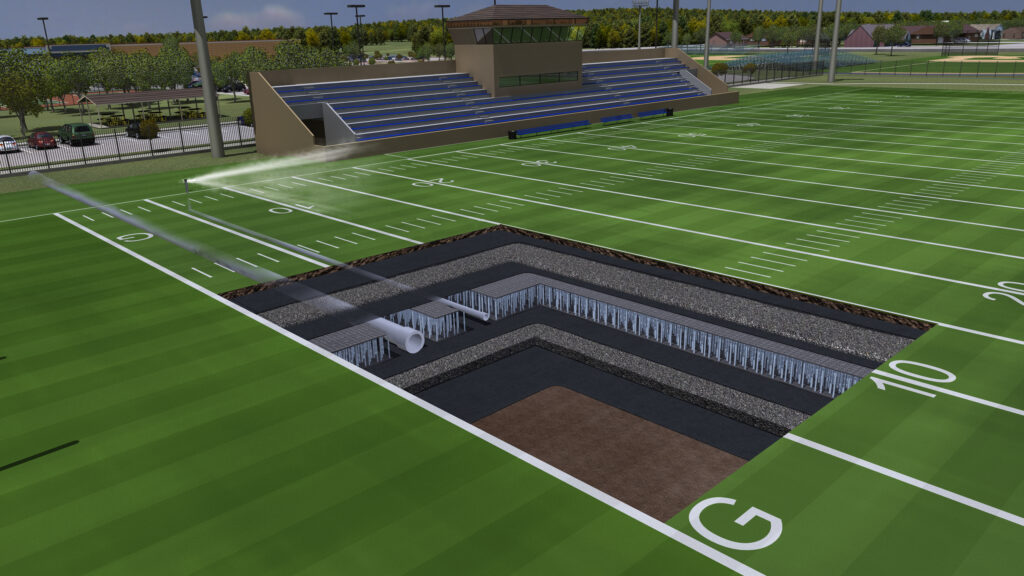
Pre-Design Project Site Assessment
Depending on the type of application (infiltration, retention or detention), several key design considerations should be incorporated into the planning, design, and installation of underground stormwater systems:
- Local regulations
- Soil characteristics and infiltration rates
- Site footprint & storage volume required
- Required treatment capacity
- Contributing drainage area
- Surrounding topography
- Utility coordination
- Required pollutant removal rates (e.g. TSS removal rate)
- Depth to seasonal high groundwater level
Infiltration applications should always include a geotechnical assessment to determine the hydrologic capacity of the soil. Detention and retention systems are more focused on capacity and rate control.
Geotechnical Assessment: What to Check
- Bearing capacity of subgrade
- Soil permeability & soil type
- Compaction of existing subgrade materials
- Presence of contaminated materials
- Depth to bedrock and water table
Micro-Climate Assessment: What to Check
A system that incorporates plant life will be informed by micro-climate conditions:
- Temperature
- Humidity
- Wind
- Precipitation
- Solar exposure
- Salt exposure in snow piling areas
Material Requirements
Below are some of the key materials required for most underground stormwater management systems. To discuss a comprehensive design for your application, get in touch with a product specialist.
Backfill Selection and Compaction
Backfill must provide structural and drainage characteristics appropriate for the application. Backfill selection is informed by:
- The type of material and compaction level
- Dimensions of the backfill envelope
- Native soil conditions
The type of material (sand, gravel, clay, etc.) and compaction level (standard Proctor density) determine overall strength of the backfill. Materials that are large and angular require less compaction than material smaller and less angular.
In some instances, native soil and locally available materials could be used for backfill, if they meet design requirements. This can help reduce material and hauling costs.
Compaction forces out air and moisture to provide a more stable structure. Minimum compaction levels are based on the material characteristics and the design load. If the soil is over-compacted during installation, the native soil infiltration rate could decline, preventing the system from functioning as designed.
Applications will require multiple levels of stone/fill, in addition to backfill. Review the installation section of this article for more details.
Inlets & Outlets
The size of the inlets and outlets are determined by flow rate, elevation, and slope. It’s imperative that inlet and outlet size are calculated correctly, otherwise flow point clogging, settling, backups to the storm sewer system, or system damage can occur.
Debris Rows
Debris Rows can be specified in modular tank applications to contain sediment and debris, reducing frequency of maintenance required. The Debris Row size is determined by the flow rate of the inlet connection to the system.
Our stormwater management technical team provides preliminary layout designs. This includes calculations, CAD drawings, and specifications to ensure that your project meets performance criteria and regulatory standards.
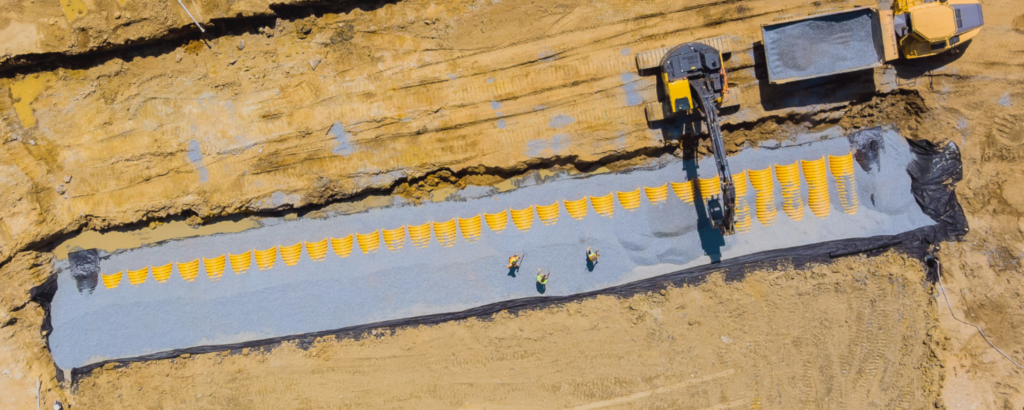
Installation & Maintenance Requirements
Installation
The installation of an underground stormwater system is unique and dependent on system specifications. However, there are general requirements for all system installations to be successful:
- Adequate subgrade preparation
- Selection of correct foundation stone, embedment stone, and/or backfill
- Adequate compaction of each layer
- Selection of correct geotextile fabric
For arch chamber applications, designs that require no structural embedment and backfill material and are not designed in accordance with AASHTO requirements may result in excessive deflections or complete failure.
Maintenance
Proper system maintenance is necessary to ensure the longevity and performance of an underground stormwater system. The main threats to the function of a system are sediment and debris buildup. Although engineers can provide areas for sediment and debris capture (Debris Rows, for example) as part of the system design, maintenance is still required at least once per year.
Our technical expertise extends to supporting contractors on proper installation of stormwater management systems. This helps ensure performance and longevity of a system, and overall project success. To learn more, get in touch with our team using the form below.
Let’s Work Together
Ready to learn more about specifying an underground stormwater management system?
We offer various underground stormwater solutions with design consultation and installation support, so your site and investment are protected.
Connect with our stormwater management team using the form below!

